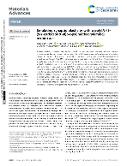Emulating synaptic plasticity with a poly[N-(3-(9H-carbazol-9-yl)propyl)methacrylamide] memristor

Author
Panthi, Yadu Ram
Pandey, Ambika
Šturcová, Adriana
Výprachtický, Drahomír
Foulger, Stephen H.
Pfleger, Jiří
Publication date
2024Published in
Materials AdvancesVolume / Issue
5 (16)ISBN / ISSN
ISSN: 2633-5409ISBN / ISSN
eISSN: 2633-5409Metadata
Show full item recordCollections
This publication has a published version with DOI 10.1039/d4ma00399c
Abstract
Synaptic plasticity, denoting the variable strength of communication between adjacent neurons, represents a fundamental property of nervous systems that governs learning/forgetting and information storage in memory. It is shown here that a memristor with a poly [N-(3-(9H-carbazole-9-yl) propyl)methacrylamide] (PCaPMA) active layer, sandwiched between ITO and Au or Al electrodes, can emulate such a function. Its resistance, stimulated by a series of low amplitude voltage pulses, can gradually increase or decrease depending on the polarity, number, and frequency of stimulation pulses. Such behaviour is analogous to the potentiation and depression of neuronal synapses. A variety of synaptic functions, including short- and long-term plasticity, paired-pulse facilitation/depression (PPF/D), spike-timing-dependent plasticity (STDP), and associative learning, have been comprehensively explored on the millisecond timescale and the results suggest the possibility of linking device functions to biological synapse processes. The reported electrical properties have been attributed to a combination of several mechanisms, such as voltage-induced conformation changes, trapping/detrapping of charge carriers at localized sites, and redox phenomena. The results suggest the potential use of this device for applications in artificial intelligence and neuromorphic computing.
Keywords
memories, mechanisms, polymer, spectra
Permanent link
https://hdl.handle.net/20.500.14178/2980License
Full text of this result is licensed under: Creative Commons Uveďte původ-Neužívejte dílo komerčně 3.0 Unported



